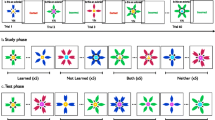Summary
Two groups of subjects were required to learn taxonomic verb lists without being given explicit information about the categories. Category size was varied. Different categories were represented in the list by 2, 4, 6, or 8 instances per category. One group learned under standard learning instructions, the other learned by performing the denoted actions. We observed higher memory performances for the enacting group in free recall and recognition in comparison with those of the standard learning group. Category size did not interact with encoding condition. Free recall, but not recognition, correlated slightly positively with category size. After the memory tests a generation-recognition procedure was carried out. Subjects were given the category names and had to generate as many items as possible without reference to the learning list. After this, they had to mark the items from the learning list in their own productions. Both groups generated an equal number of items per category, but the proportion of generated old items and of recognized self-generated items was higher for the enacting group than for the standard learning group. The conclusion is discussed that enacting did not change relational information, but made items more accessible in memory.
Similar content being viewed by others
References
Anderson, J. R., & Bower, G.-H. (1982). Recognition and retrieval previous in free recall.Psychological Review, 79, 97–123.
Brown, J. (1968). Reciprocal facilitation and impairment in free recall.Psychonomic Science, 10, 41–42.
Brown, J., & Lewis, V. (1981). The relationship between item retrievability and item discriminability and their intersections with item frequency and personal significance.American Journal of Psychology, 94, 247–265.
D'Agostino, P. R., & Elmes, D. G. (1987). Effect of mobilization of knowledge on recognition and recall.Journal of Experimental Psychology: Learning, Memory, and Cognition, 13, 175–181.
Einstein, G. O., & Hunt, R. R. (1980). Levels of processing and organization: Additive effects of individual item and relational processing.Journal of Experimental Psychology: Human Learning and Memory, 6, 588–598.
Engelkamp, J. (1990).Das menschliche Gedächtnis. Göttingen, Hogrefe.
Gillund, G., & Shiffrin, R. M. (1984). A retrieval model for both recognition and recall.Psychological Review, 91, 1–67.
Graf, P., & Mandler, G. (1984). Activation makes words more accessible, but not necessarily more retrievable.Journal of Verbal Learning and Verbal Behavior, 23, 553–568.
Graf, P., Mandler, G., & Haden, P. (1982). Simulating amnesic symptoms in normal subjects.Science, 218, 1243–1244.
Humphreys, M. S., Bain, J. D., & Pike, R. (1989). Different ways to cue a coherent memory system: A theory for episodic, semantic, and procedural tasks.Psychological Review, 96, 208–233.
Hunt, R. R., & Einstein, G. O. (1981). Relational and item-specific information in memory.Journal of Verbal Learning and Verbal Behavior, 20, 497–514.
Hunt, R. R., & Seta, C. E. (1984). Category size effects in recall: The roles of relational and individual item information.Journal of Experimental Psychology, 10, 454–464.
Jones, G. V. (1982). Tests of the dual-mechanism theory of recall.Acta Psychologica, 50, 61–72.
Karchmer, N. A., & Winograd, E. (1971). The effects of studying a subset of familiar items on recall of the remaining items: The John Brown effect.Psychonomic Science, 25, 224–225.
Knopf, M., & Neidhardt, E. (1989). Gedächtnis für Handlungen.Sprache & Kognition, 8, 203–215.
Marschark, M., & Hunt, R. R. (1989). A reexamination of the role of imagery in learning and memory.Journal of Experimental Psychology: Learning, Memory, and Cognition, 15, 710–720.
Mohr, G., Engelkamp, J., & Zimmer, H. D. (1989). Recall and recognition of self-performed acts.Psychological Research, 51, 181–187.
Nickerson, R. S. (1984). Retrieval inhibition from part-set cueing: A persistent enigma in memory research.Memory & Cognition, 12, 531–552.
Nilsson, L. G., & Bäckman, L. (1989). Implicit memory and the enactment of verbal instructions. In S. Lewandowsky, J. C. Dunn, & K. Kirsner (Eds.),Implicit memory: Theoretical issues (pp. 173–184). Hillsdale: Erlbaum.
Nilsson, L. G., Cohen, R. L., & Nyberg, L. (1989). Recall of enacted and nonenacted instructions compared: Forgetting functions.Psychological Research, 51, 188–193.
Raaijmakers, J. G. W., & Shiffrin, R. M. (1980). SAM: A theory of probabilistic search of associative memory. In G. H. Bower (Ed.),The psychology of learning and motivation (Vol. 14, pp. 207–262). New York: Academic Press.
Rabinowitz, M., Mandler, G., & Barsalou, L. W. (1979). Generationrecognition as an auxiliary retrieval strategy.Journal of Verbal Learning and Verbal Behaviour, 18, 57–72.
Tulving, E., Schacter, D. L., & Stark, H. A. (1982). Priming effects in word fragment completion are independent of recognition memory.Journal of Experimental Psychology: Learning, Memory, and Cognition, 8, 336–342.
Zimmer, H. D. (1990).On the importance of item-specific and relational information for memory of subject-performed tasks. Paper given at the 4th Conference of the ESCP at Como (Italy).
Zimmer, H. D., & Engelkamp, J. (1989). Does motor encoding enhance relational information?Psychological Research, 51, 158–167.
Zimmer, H. D., Engelkamp, J., Mohr, M., & Mohr, G. (1989). Organisation und Behalten im multimodalen Modell. (Arbeiten der Fachrichtung Psychologie Nr. 125). Saarbrücken: Universität
Author information
Authors and Affiliations
Additional information
This research was supported by a grant from the German Science Foundation (Deutsche Forschungsgemeinschaft) to J. Engelkamp and the author under En 124/8-1.
Rights and permissions
About this article
Cite this article
Zimmer, H.D. Memory after motoric encoding in a generation-recognition model. Psychol. Res 53, 226–231 (1991). https://doi.org/10.1007/BF00941391
Issue Date:
DOI: https://doi.org/10.1007/BF00941391




